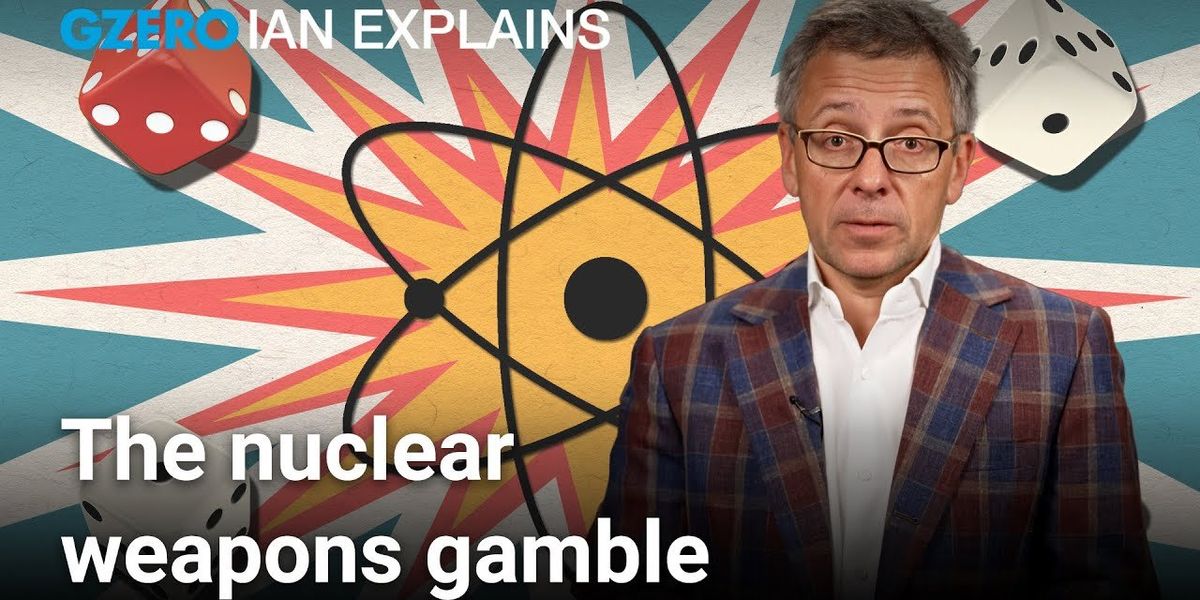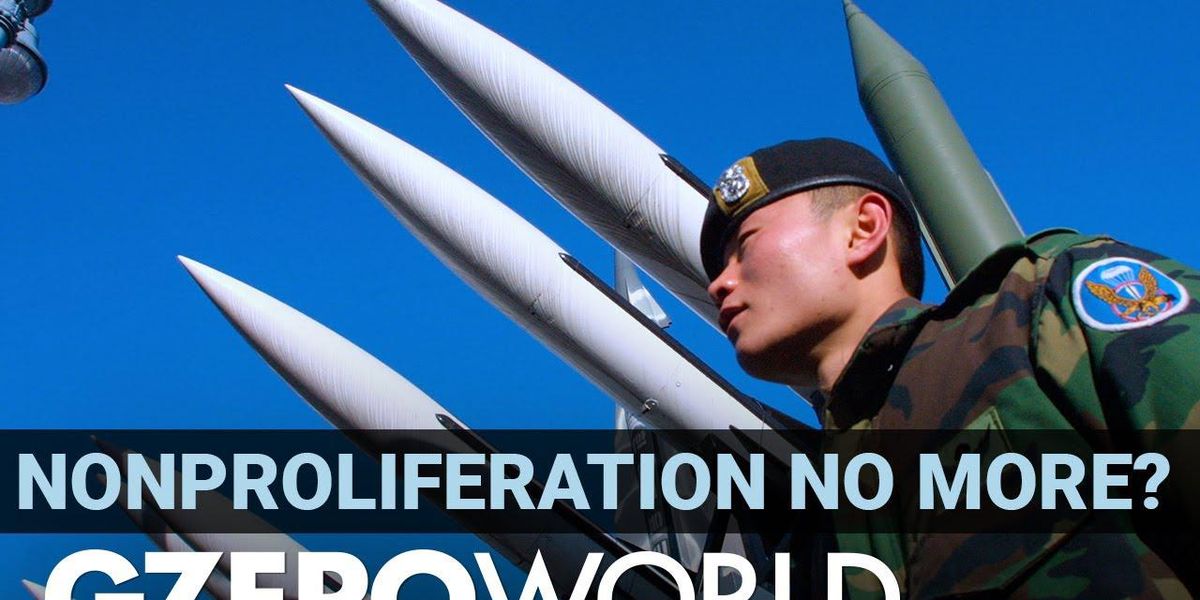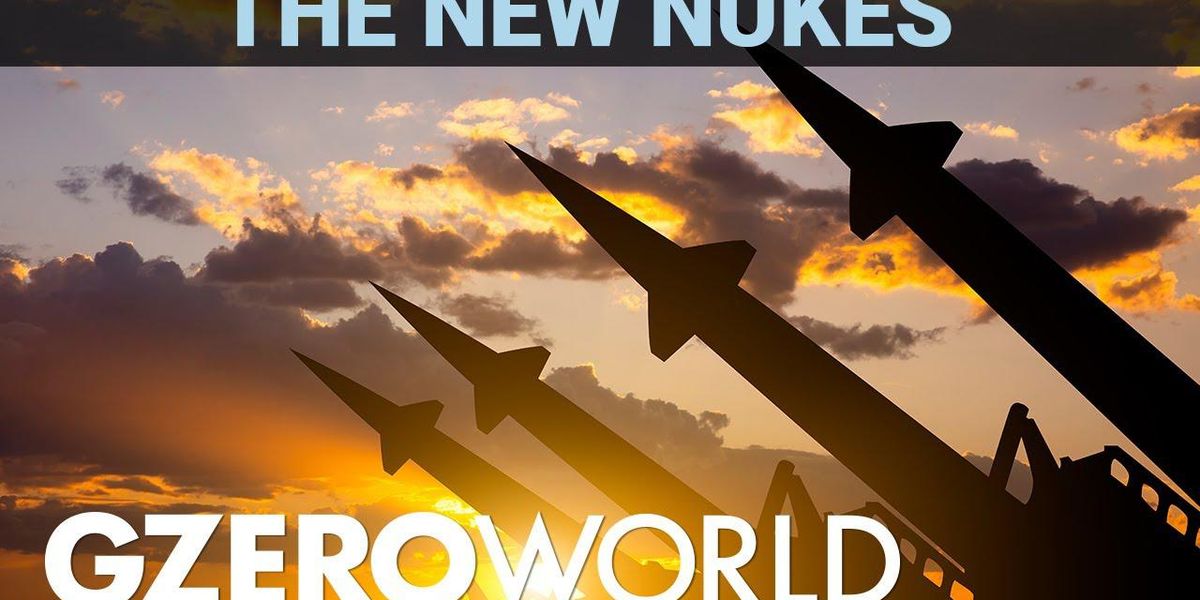Trending Now
We have updated our Privacy Policy and Terms of Use for Eurasia Group and its affiliates, including GZERO Media, to clarify the types of data we collect, how we collect it, how we use data and with whom we share data. By using our website you consent to our Terms and Conditions and Privacy Policy, including the transfer of your personal data to the United States from your country of residence, and our use of cookies described in our Cookie Policy.
{{ subpage.title }}
Do nuclear weapons make a country safer?
Does acquiring nuclear weapons make your country safer? It’s a difficult question. On Ian Explains, Ian Bremmer looks back to the 1990s and a tale of two radically different nuclear—Ukraine and North Korea.
Ukraine inherited the world’s third-largest nuclear arsenal after the Soviet collapse. They gave them up in 1994 in exchange for security assurances from the US, UK and Russia. But assurances aren't guarantees, and a decade later, Russia illegally annexed Crimea before launching its full-scale invasion in 2022. Meanwhile, North Korea abandoned diplomacy, pursued nuclear weapons, and lied to the world all along. Now it’s a global pariah, but the uncomfortable truth is nobody’s thinking of invading North Korea. So did Kyiv get played? Did Pyongyang make a smarter move? The contrast between Ukraine’s vulnerability and North Korea’s impunity seems stark. But the story is more complicated. Building nuclear weapons is a gamble, not a strategy. Watch Ian Explains to understand why and what it means for the growing nuclear threat in 2025.
GZERO World with Ian Bremmer, the award-winning weekly global affairs series, airs nationwide on US public television stations (check local listings).
New digital episodes of GZERO World are released every Monday on YouTube. Don't miss an episode: subscribe to GZERO's YouTube channel and turn on notifications (🔔).
President Donald Trump speaks during a meeting with Israeli Prime Minister Benjamin Netanyahu in the Oval Office on April 7, 2025. REUTERS/Kevin Mohatt
US-Iran talks to be held this weekend
On Monday, President Donald Trump said that the US has been engaged in “direct” talks with Iran over its nuclear program and said that a meeting with “very high-level” officials is set for this Saturday. That would be a sharp break from previous US-Iran talks, which have occurred mostly through intermediaries.
But Iran’s Foreign Minister Abbas Araghchi denied the “direct” aspect of these talks, confirming that the US and Iranian negotiators will meet in Oman on Saturday, but that they would remain in separate rooms as Omani diplomats carry messages back and forth.
Whatever the format, Trump made it clear that he expects progress. “If the talks aren’t successful with Iran, I think Iran is going to be in great danger,” he warned. “And I hate to say it, great danger, because they can’t have a nuclear weapon. You know, it’s not a complicated formula. Iran cannot have a nuclear weapon. That’s all there is.”
While a breakthrough this weekend is unlikely, the talks suggest that both sides see an advantage in finding out whether a deal with the other side is possible.
There are other hopeful signs of a deal. In response to warnings from US officials of looming air attacks by American forces, the leaders of four of the largest Iran-backed militia groups operating in Iraq told Reuters on Monday that they were prepared to surrender their weapons to Iraqi government authorities. Iraqi Prime Minister Mohammed Shia al-Sudani has reportedly met with militia commanders and urged them to disarm, according to Iraqi state officials who requested anonymity.
The militia commanders also said that the Iran Revolutionary Guard Corps, their prime supplier of weapons and money, had agreed to let local group leaders inside Iraq decide how best to respond to Trump’s threats.
Though these militia moves are more likely a tactical retreat than a true surrender, any move to disarm would give the Trump administration a notable foreign-policy victory without an attack. The so-called Islamic Resistance in Iraq, a group of about 10 heavily-armed Shia militias with a total of 50,000 fighters and access to heavy weapons, including long-range missiles, has attacked both Israeli and US military targets in the past.
People walk by as a painter repaints an anti-US mural in Tehran, Iran, on Saturday, March 29, 2025.
Trump warns he’ll bomb Iran over lack of nuclear deal
On Sunday, US President Donald Trump issued a stark warning to Iran, threatening to bomb the country and impose secondary tariffs if Tehran fails to reach a new agreement on its nuclear program. In a telephone interview with NBC News, Trump stated, “If they don’t make a deal, there will be bombing. It will be bombing the likes of which they have never seen before.”
Trump’s threat follows Iran’s rejection of direct negotiations with Washington, which the US President had offered in a letter sent to Tehran on March 12. On Sunday, Iranian President Masoud Pezeshkian stated, “We responded to the US president’s letter via Oman and rejected the option of direct talks, but we are open to indirect negotiations.”
What’s Trump’s goal? The US administration’s renewed “maximum pressure” campaign seeks to curb Iran’s nuclear ambitions and regional influence through economic damage, and it has sent the rial tumbling. Iran maintains that its nuclear program is solely for civilian purposes, something the US rejects, and a recent report from the International Atomic Energy Agency found that Iran has ramped up its manufacturing of near weapons-grade uranium.Polish Prime Minister Donald Tusk attends a European Union leaders special summit to discuss Ukraine and European defense in Brussels, Belgium, on March 6, 2025.
Might Poland go nuclear?
As Ukraine’s Volodymyr Zelensky was in Saudi Arabia Monday ahead of US-Ukrainian talks, his military launched its largest drone attack on Moscow overnight, killing two people. And if you ask Elon Musk, he was also busy attacking X. On Monday, Musk claimed without evidence that his social media platform went dark yesterday because it was targeted by a “massive cyberattack” traced to “the Ukraine area.”
Meanwhile, Poland’s Prime Minister Donald Tusk has made waves in recent days.
When Poland joined NATO in 1999, it appeared the country could count on the most successful military alliance in history to protect its borders against future threats. At the time, an American renunciation of NATO was hard to imagine.
On Friday, Tusk warned his country that a “profound change of American geopolitics” forces his government to prepare to double the size of its military and to “reach for opportunities related to nuclear weapons.” In the past, Poland’s leaders have suggested hosting the nuclear weapons of others, but the hint that Poland might develop its own arsenal in response to potential Russian aggression and a feared US retreat from Europe is something new.
Tusk’s jarring comments reflect a spiral in relations between Tusk’s government and the Donald Trump administration. A series of accusations and insults flew over the weekend between Poland’s foreign minister, Trump adviser Elon Musk, and US Secretary of State Marco Rubio over the Musk-owned Starlink satellite system that supports Ukraine’s forces on the battlefield.
The PM’s suggestion that Poland might look to nuclear weapons in part reflects political worries. Poland will hold a first round of presidential elections in May, and Poles look likely to back a leader they believe can stand up to both Trump and Vladimir Putin.
But acquiring nuclear weapons would be time-consuming, politically fraught, and enormously expensive for Poland.
Military vehicles carrying DF-41 intercontinental ballistic missiles travel past Tiananmen Square during the military parade marking the 70th founding anniversary of the People's Republic of China, on its National Day in Beijing, China, on Oct. 1, 2019.
Beijing flexes nuclear muscle, sends signal to US
Why now? Conducting a rare and provocative test might seem out of step with the softer touch Beijing has taken in foreign affairs this year. It comes in the middle of the United Nations General Assembly, just ahead of a planned phone call between Presidents Joe Biden and Xi Jinping, and just after the People’s Bank of China announced a raft of measures to fight persistent economic malaise.
Eurasia Group expert Jeremy Chan says a few causes could be behind the timing of the launch, most of which seem directed at the US. Though Beijing has been attempting to stabilize relations with Washington, increasing closeness between American allies like Japan, the Philippines, and South Korea makes China feel hemmed in. Frustration is also growing in Beijing over tightening US-led export controls on China’s access to advanced technology, as well as expanded sanctions against Chinese firms for their alleged support for Russia’s defense industrial base. Beijing is likely also angered by the US backtracking on earlier commitments made to China to withdraw a Typhon missile system that has been deployed to the Philippines since April. Shooting a city-killer missile just north of the archipelago’s largest island may serve as a useful reminder.
“Beijing might be saying ‘We’re not happy about the US backing away from its commitment to remove the Typhon system, and we’re going to express our displeasure by flying our long-range missile directly over the location of your mid-range missiles,’” Chan explains.
We’re watching whether the US and the Philippines get the message and whether the incident comes up as Biden prepares for the last few set pieces over which he will preside in the US-China relationship.
Norris Bradbury, group leader for bomb assembly, stands next to the partially assembled Gadget atop the test tower at Los Alamos in 1945.
Building the bomb, tickling the dragon
“Tickling the dragon’s tail.” That’s how the small group of physicists working at Los Alamos in the 1940s under the watch of Robert Oppenheimer described the dangerous job of assembling a nuclear core for the first atomic bomb. One wrong move and a chain nuclear reaction — the dragon — could have wiped them all out.
Even though the Manhattan Project was America’s most sensitive and secretive task — and the focus of the new Christopher Nolan film that opens tomorrow — Canada and the UK also contributed to the work. And at the very heart of it was a Jewish Canadian scientist named Louis Slotin, who emerged as the bomb assembler-in-chief. He worked with the radioactive material to build the core of the bomb — literally tickling the dragon by hand — a skill that led to his fame, but also to his gruesome, slow death by radiation poisoning in 1946.
Slotin was one of about 35 Canadian scientists working at Los Alamos. But Canada’s most crucial contribution — outside the academic work done in places like the famed Montreal Lab – was likely the Eldorado Mine on Great Bear Lake in the Northwest Territories, which supplied uranium to the bomb project. Canada’s uranium was hauled down from the north and refined in a lovely little Lake Ontario town between Ottawa and Toronto called Port Hope, before being shipped to Los Alamos to be used in Fat Man and Little Boy, the bombs that were eventually dropped on Hiroshima and Nagasaki.
The US-Canada link was so strong that by 1944 the first nuclear reactor outside of the United States was built in Canada in a place called Chalk River, not far from Ottawa — which leads to another fascinating thread … In 1952, there was a nuclear meltdown at the Chalk River plant, and a 28-year-old American naval officer with expertise in nuclear power named Jimmy Carter — yes, the man who would go on to become the 39th US president — rushed in and prevented the accident from becoming catastrophic.
Still, as the new film “Oppenheimer” examines, developing the bomb remains a moral morass, one which Oppenheimer and Slotin openly struggled with. Were they, as Oppenheimer later claimed to have said, the destroyers of worlds, or did they save lives? That moral debate continues.
As nuclear fears reemerge with the war in Ukraine and the NATO alliance is reanimated in its purpose, it’s worth examining again how the world should handle its nuclear capabilities. While Oppenheimer’s later life was subsumed by political suspicion that he was a Communist (there is no evidence he gave the Russians any secrets), Slotin never lived to see that. In 1946, while working at Los Alamos, he was tickling the dragon’s tail by hand when there was an accident, and he was fatally irradiated. He cooked from the inside and slowly, painfully, melted down. His life is a stark reminder that the nuclear dragon is still very much alive, and as we covered recently on our GZERO World PBS program when Ian Bremmer interviewed the International Atomic Energy Agency chief Rafael Grossi, the dragon remains very, very difficult to tame.
Nuclear nonproliferation has worked so far, but watch out for those questioning it — arms control expert
Nuclear nonproliferation treaties have been a success at stopping the atomic club from growing further by discouraging new membership, but nuclear weapons expert Kelsey Davenport says the slow pace of disarmament "is causing some states to begin to question that bargain." Although it's unlikely that nuke-curious countries will actually get the bomb because it costs too much time, money and resources, Davenport told Ian Bremmer on GZERO World that she believes that simply questioning the benefits of nonproliferation creates a real risk that must be "monitored and mitigated."
Watch the episode: Nuclear weapons: more dangerous than ever?
Nuclear weapons: more dangerous than ever?
In recent years, as nuclear disarmament worldwide has slowed to a crawl, world powers are engaging in a new kind of arms race: a technological one. Today's nuclear threat is not about who has the most nukes, it's about who has the smartest ones. Arms control expert Kelsey Davenport joins Ian Bremmer on GZERO World to talk about the world's long fascination with these horrible weapons and how close we still remain to all-out nuclear war.
- The new nuclear arms race: Smarter, faster nukes - GZERO Media ›
- The Graphic Truth: Nuclear weapons — who has what? - GZERO ... ›
- Is the Iran nuclear deal dead – again? - GZERO Media ›
- New US president, same old focus on Iranian bomb - GZERO Media ›
- Nuclear weapons could be used; Russia's war gets more dangerous ›
- What happens if Russia nukes Ukraine? - GZERO Media ›
- How do we avert nuclear disaster in 2023? - GZERO Media ›
- Putin's nuclear calculus and the Ukraine Paradox - GZERO Media ›
- Cuban Missile Crisis turns 60 - GZERO Media ›


